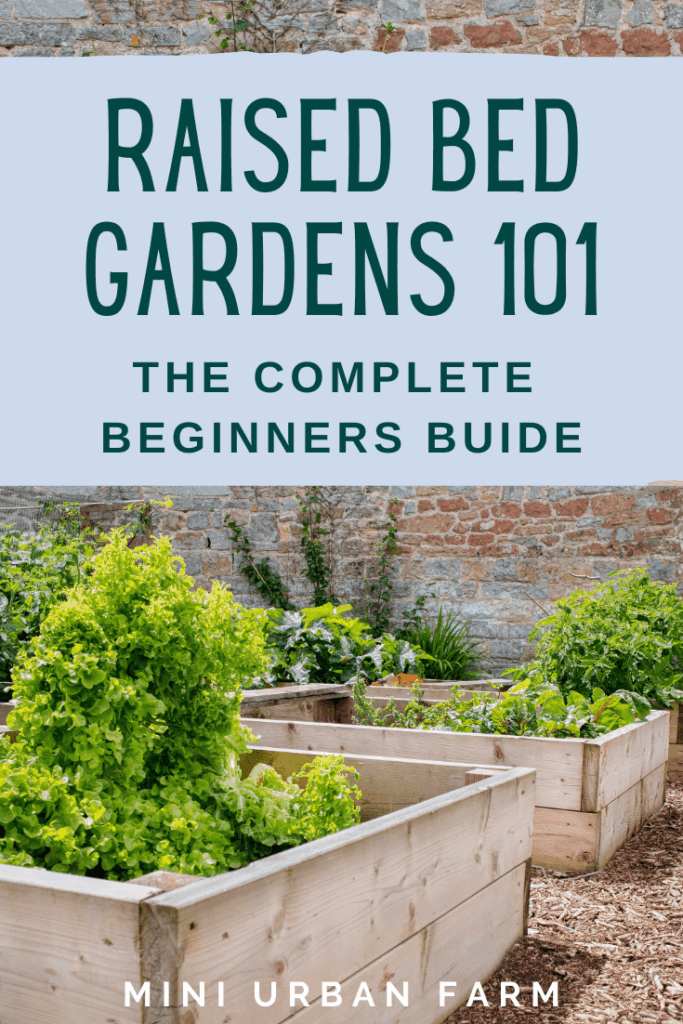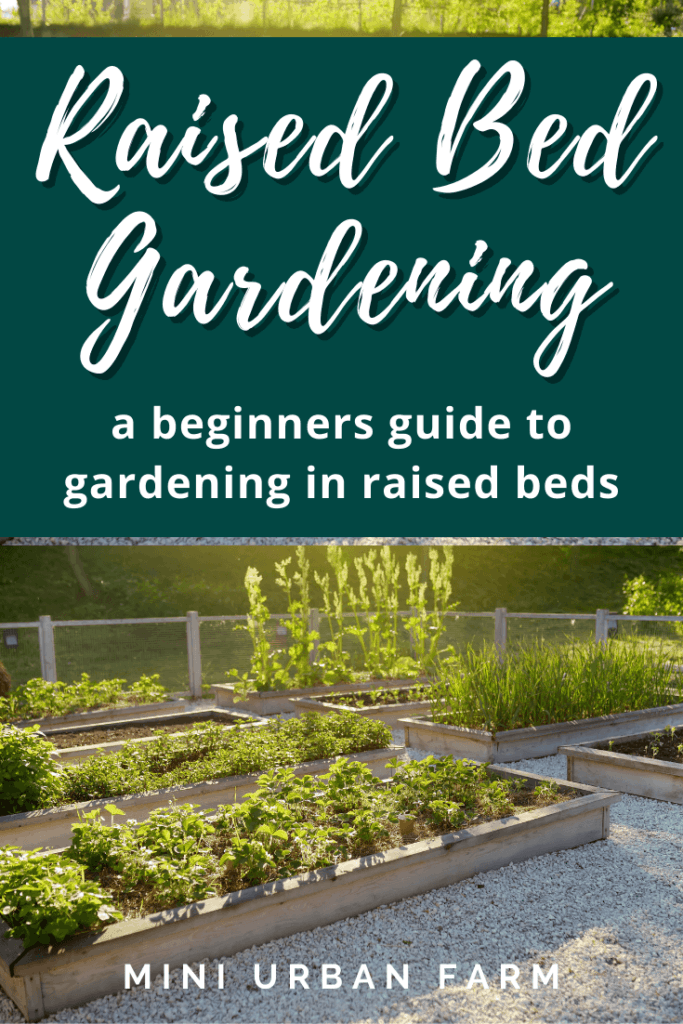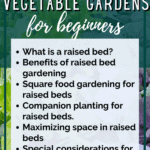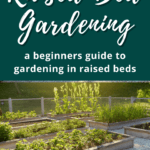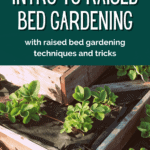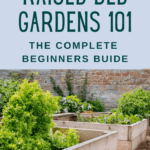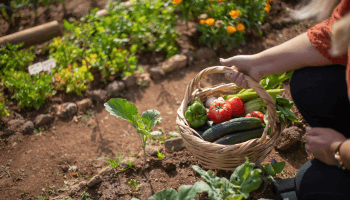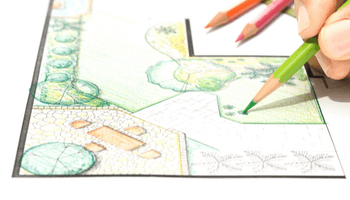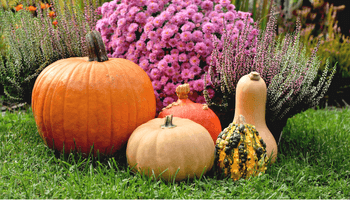If you’re looking to start a garden for the first time, chances are you don’t know where to start. Should you start a raised bed or an in-ground bed? How big does it need to be? And how do I take care of it? Well, if you live in the suburbs, especially in an HOA, your best bet is usually a raised bed vegetable garden. These are great for beginners and can be any size you want. So let’s jump right into raised bed vegetable gardening for beginners!
- What is a raised bed?
- Benefits of raised bed gardening
- Square food gardening for raised beds
- Companion planting for raised beds.
- Maximizing space in raised beds
- Special considerations for raised beds
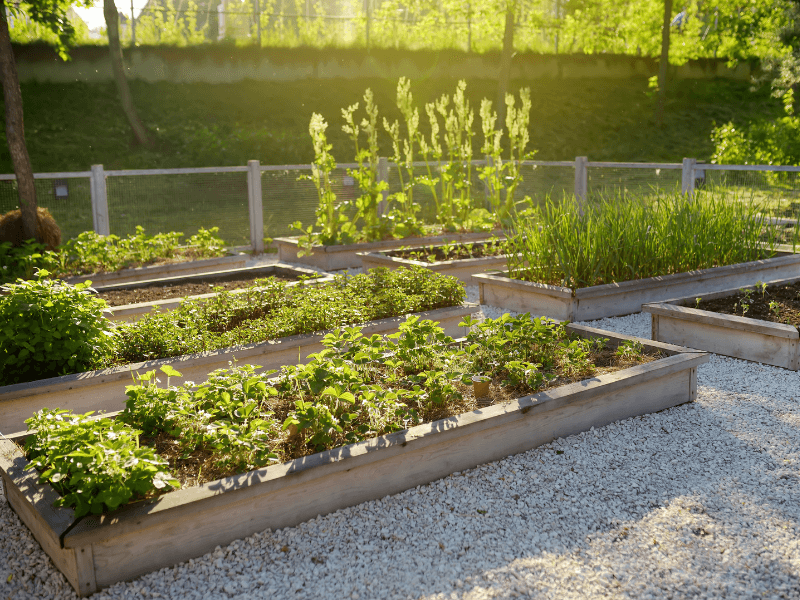
Disclosure: This post may contain affiliate links. If you purchase a product through one of our affiliate links we make a small commission from the sale at no extra cost to our readers.
RAISED BED VEGETABLE GARDENING FOR BEGINNERS
Gardening not only gives you natural, fresh food but is also a great step towards self-sufficiency.
However, you’re going to need some gardening basics before jumping in, and you’ve come to the right place!
These amazing raised bed vegetable gardening for beginners tips can set you up for a green thumb in no time! Plus, check out some of these urban gardening tips if you live in Suburbia like we do!
WHAT IS A RAISED BED?
Many urban farmers, due to lack of in-ground space, HOA regulations, or desire not to bend over all the time, build raised beds to plant their crops.
This helps them live sustainably by eating freshly grown foods coming from their garden – even if the “garden” is on their back patio.
What are raised beds you ask?
A raised bed, also known as a garden box, is basically a box that sits on top of the existing soil (or concrete or whatever) and is used to plant vegetables, herbs, flowers, etc.
These boxes can be built out of wood, metal, plastic, or just about any other material that can hold the soil in!
And, they can be whatever shape you want – not just rectangular.
Essentially, a raised bed just means a garden bed that allows the roots of plants to grow above ground.
You can see my entire garden set up on my YouTube channel 🙂
BENEFITS OF RAISED BED GARDENING
Raised beds are an awesome way for a gardener to plant their favorite crops, especially if they don’t have vast space to dedicate to a garden.
And besides planting the veggies you like, raised beds allow you to plant crops pretty much anywhere you like!
Other benefits include:
Less Bending Over
If you have ever gardened on the ground, you know how back-breaking it can be.
With raised beds, planting and weeding are kind to your back.
This is because there is less bending involved in raised bed gardening, which makes you hurt less and keeps your back healthy.
You can make the raised bed as tall as you want, also.
If you prop it up on legs, you have virtually no need to bend down.
Better Soil If Your Ground Soil Is Poor
If you want to start gardening and your area does not have healthy, rich soil, raised beds can solve that problem!
This is because you can buy rich soil and dump it in your raised beds, instead of relying on only what you have in the ground.
And you don’t have to worry that the soil will be poor, since you can add in any type of soil and amendments you want!
Plus, if you’re wondering what soil to put in raised beds, I make my own mixture of half peat moss and half compost as an easy raised bed soil mix!
HOA Friendly
In many areas, the Homeowners Association (HOA) sets no-gardening rules, which prohibit home buyers or renters from planting any kinds of vegetables in the ground in their backyard.
This can be specific to certain types of trees, or it can be all-inclusive to “no fruiting plants in-ground” like where I live.
So if you live in a community that regulates in-ground plants like I do, you can usually get away with raised garden beds instead!
Fewer Weeds
Raised beds are great in reducing weed growth.
This is because you are adding in the soil you want, without all of the extra particles, roots, and seeds that might be already present in the earth.
Plus, the taller you make the sides of your raised beds, the harder weeds have to fight to get through all that soil!
Keeps Soil From Eroding
One of the most amazing benefits of having a raised bed is that it prevents soil erosion compared to when you plant your crops on the ground.
Because soil is not compacted in a raised bed, it leaves enough space for water to access through, which allows it to be absorbed faster than the ground soil.
This helps keep the soil intact when there’s wind and water erosion on the ground soil.
But, it is important to mulch and amend your raised beds to keep the soil healthy, rich in nutrients, and curb erosion.
Roots Go Further Into The Soil
Unlike garden planters that have a bottom that restricts roots from spreading further, raised beds can be “bottomless,” allowing for extra space for roots to grow.
Now, if your raised beds are elevated on legs, then of course they need to have a bottom.
But if you are just laying them on top of the ground, then there’s no need for a bottom to the bed.
Going “bottomless” will allow those veggie roots to grow deeper into the ground, making your plants stronger in the long run!
You Can Plant Earlier in the Season
Did you know that you can plan earlier in the season if you have a raised bed?
It’s true!
This is because the soil in raised beds warms up faster than ground soil, which makes it ideal for early planting.
Since the soil is not compacted and drains easily, air flows through the soil more quickly, warming up the ground before the earth warms up for Spring planting!
Helps Avoid Contaminated Soil
Many people living in urban areas have come into contact with contaminated soil because of manufacturing, land development, waste disposal, excessive use of insecticides and pesticides, among others.
This causes the soil to become contaminated with heavy metals such as lead, which steals away soil nutrients.
With raised beds, you are protected from soil contamination, which allows you to grow healthy, organic crops.
SQUARE FOOT GARDENING FOR RAISED BEDS
Square foot gardening and raised bed gardening go together like PB and jelly! It’s really essential to planning your raised bed vegetable garden layout.
This is especially true if your beds are square or rectangular shaped, allowing them to be divided up easily into perfect little square foot boxes.
The main reason I use this method in my beds, however, is that I can easily calculate how many plants I can fit into each bed.
This allows me to start just the right amount of seeds and estimate how much food I can grow!
Plus, it shows me the best vegetables to grow in raised beds!
Nothing like some garden math to get your motivation up!
The basics of square foot gardening in raised beds are as follows:
- Divide your raised bed into square feet. If your bed is 6 feet by 2 feet, you now have 12 square feet to work with. I like to mark each foot on the sides of the boxes with a little tick mark.
- Once you know how many square feet you have, outline the vegetables you want to grow. Then determine how many of those vegetables can fit into one square foot. It’s helpful to search for “tomatoes per square foot.”
- Then determine how many of each plant you can fit in your raised beds, playing around with the different numbers until you are happy with the results.
- And if you really want to go down the rabbit hole, take those 6 tomato plants you decided on, and multiply by the number of pounds of tomatoes you will get from each plant! This will give you an estimate of how much food you can grow in your space.
- Rinse and repeat every season!
This is one of my absolute favorite ways to grow more food in less space – something that my Starting Your Urban Vegetable Garden workbook goes into in detail!
COMPANION PLANTING FOR RAISED BEDS
Companion planting is another amazing gardening technique that I use every day in my garden.
It involves planting vegetables together that will complement each other – or at the very least won’t kill each other!
You see, some plants are heavy feeders and take a lot of nutrients from the soil.
Now, there is a limit on the amount of nutrients in the soil and planting two things next to each other that are both heavy feeders may leave one crop nutrient-deficient.
In this case, you’d want to plant things together that balance each other out – like tomatoes and beans.
While tomatoes take lots of nutrients from the soil, beans actually give back to the soil, which helps balance out your mini ecosystem!
More benefits of companion planting in raised beds:
- Pest control – certain crops, like herbs, actually emit strong fragrances which pests hate. So planting those out next to your veggies can help ward off unwanted pests
- Shade – taller plants are good at providing shade for the shorter plants and also prevent strong winds from blowing away the smaller plants
- Ground cover – leaving the soil exposed underneath plants can be detrimental to the plant’s health. So planting out a living mulch like herbs can cover the soil and give you extra food too!
- Support – some plants that need support attach themselves to other plants, which helps them grow healthy and strong. For example, corn stem is a natural trellis for beans.
- Attracting beneficial insects – some plants attract beneficial insects such as bees, which pollinate plants. This pollination improves crop quality and yield. Planting things that attract these insects will help your garden overall
- Filling in gaps between plants – no more wasted space! Use companion plants to get the most of your urban garden!
- Acting as decoy plants – planting out a decoy plant that will attract pests will help keep those same pests away from your more valuable veggies!
Psst…want to fast track your garden? Get access to my FREE gardening resource library and start maximizing your garden today!
MAXIMIZING SPACE IN RAISED BEDS
Raised bed gardening is a favorite urban gardening technique since the suburbs are not always a great environment for growing food.
And by combining this with other urban gardening techniques, I maximize my space which allows me to grow all my own herbs and veggies!
Here are some ways you can maximize space and plant more crops too!
- Vertical gardening – Build a trellis on your raised bed. This allows you to grow more plants in a limited space.
- Optimize spacing between your garden beds – Make the spacing between your beds wide enough for you to pass through with tools such as water buckets, but close together such that you are not wasting any precious space.
- Succession planting – This means planting crops that complement each other timewise. For example, if you plant cauliflower, it takes at least six weeks before it starts to fill out. You can plant vegetables that mature quickly in between the spaces such as spinach, lettuce, or arugula. You get a harvest from your leafy greens first, allowing your slower growing crops to take their time.
SPECIAL CONSIDERATIONS FOR RAISED BEDS
As great as having raised beds are, there are special considerations to factor in before deciding to start your raised-bed vegetable garden. These include:
- You will need to keep refilling the soil/topdressing with compost every season as the soil compacts
- Water evaporates faster in raised beds. This can give rise to the risk of drought stress for your crops unless you water them frequently. You can avoid this by installing a drip irrigation system with a timer
- It’s more expensive to buy all the materials and soil. Unlike the ground gardens, raised beds can cost you a pretty penny when you’re just starting out. I’ve outlined all the costs for my most recent raised bed garden and how to build a raised bed right here
- Drip irrigation is more difficult to install. While drip irrigation uses less water, which reduces wastage, it is more difficult to install in raised beds than in an in-ground garden.
Knowing these things beforehand will help you get the most out of your garden and prepare you for maintaining your new raised beds!
Now, using these raised bed vegetable gardening for beginners principles, you’re ready to get started on your own urban garden! And don’t worry, if you’re just starting out, practice makes perfect! So just keep growing and you’ll have a green thumb in no time!
Pin Raised bed vegetable gardening for beginners!
